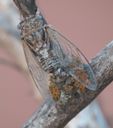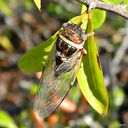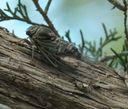Scrub Cicadas
Diceroprocta
Classification
- Phylum: Arthropoda
- Subphylum: Hexapoda
- Class: Insecta
- Order: Hemiptera
- Suborder: Auchenorrhyncha
- Infraorder: Cicadomorpha
- Superfamily: Cicadoidea
- Family: Cicadidae
- Subfamily: Cicadinae
- Tribe: Fidicini
- Genus: Diceroprocta
Pronunciation
How to pronounce Diceroprocta: /daɪˌsɛroʊˈprɒktə/
These audio files are automatically generated. While they are not always 100% accurate, they are a good starting point.
Images






Summary
Diceroprocta is a diverse genus of scrub cicadas with at least 60 described species. They are known for their distinctive calls and robust appearance, often residing in scrub and open woodland habitats across North America.
Physical Characteristics
Cicadas in the genus Diceroprocta typically have a robust body with a distinct head and large, membranous wings. Coloration can vary widely among species, often exhibiting shades of green, brown, or yellow.
Identification Tips
Look for the unique wing patterns and body shapes that distinguish different species within the genus. Call similarities can also help in identifying specific species.
Habitat
Diceroprocta species are often found in scrub habitats, grassy areas, and open woodlands where they can access sunlight and vegetation.
Distribution
This genus of cicadas is primarily distributed across North America, with specific species found in various regions, particularly in warmer climates.
Diet
Diceroprocta cicadas are sap-sucking insects, feeding on the xylem fluid of plants using specialized mouthparts.
Life Cycle
Most Diceroprocta species are considered annual, undergoing multiple overlapping generations throughout the year, predominantly from late spring to fall.
Reproduction
Males produce characteristic mating calls to attract females, which lay eggs in plant stems or the ground. The precise reproductive strategies may vary between species.
Predators
Natural predators include birds, small mammals, and other insectivorous animals that may prey on cicadas.
Ecosystem Role
Diceroprocta cicadas serve as pollinators and as a food source for various predators, contributing to the ecological balance in their habitats.
Cultural Significance
Cicadas, including those in the genus Diceroprocta, are often noted for their distinctive sounds and have cultural importance in various communities, sometimes linked to folklore or seasonal changes.
Collecting Methods
- Visual observation
- Netting
- Sound recording to attract individuals
Preservation Methods
- Ethanol preservation
- Drying specimens
- Pinning for display
Evolution
Diceroprocta belongs to the larger family Cicadidae and shows a significant evolutionary adaptation related to their life cycles and ecological roles as sap-sucking insects.
Misconceptions
Some Diceroprocta species can be misidentified due to their similar morphological features and sounds. Additionally, they may be confused with other genera of cicadas.
Tags
- Cicadas
- Diceroprocta
- Insecta
- Hemiptera
- Cicadidae